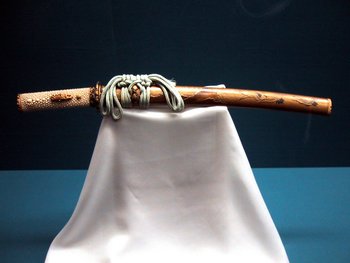Wakizashi
|
|
A wakizashi (Japanese: 脇差) is a traditional Japanese sword with a shoto blade between 12 and 24 inches (between 30 and 60 cm, with an average of 50 cm), similar to but shorter than a katana but also quite longer than the kodachi. The wakizashi is usually worn together with the katana by the samurai or swordsmen back in feudal Japan. When worn together the pair of swords were called daisho, which translates literally as "large and small"; "dai" or large for katana, and "sho" for wakizashi. The katana was much of the time called the sword or the long sword and the wakazashi, the companion sword.
Wakizashi were made with different zukuri shapes and sizes, and were generally thinner than katana. They very often had much less niku (literally 'meat' or 'flesh', the measure of how convex the edge is) and therefore cut softer targets much more aggressively than a katana. Its hilt is normally of a square shape but on rare occasion it had none.
A wakizashi was used as a samurai's weapon when the Katana was unavailable. When entering a building, a samurai would leave his katana on a rack near the entrance. However, the wakizashi would be worn at all times, and therefore, it made a sidearm for the samurai (similar to a soldier's use of a pistol). The samurai would have worn it from the time they awoke to the time they went to sleep. In earlier periods, and especially during times of civil wars, a tanto was worn in place of a wakizashi.
On a side note: Ōgami Ittō's Dotanuki (From Lone Wolf and Cub by Kazuo Koike, Goseki Kojima) is a Wakizashi.
See also
Template:Weapon-stubid:Wakizashi
ms:Wakizashi
de:Wakizashi
es:Wakizashi
fr:Wakizashi
he:ואקיזאשי
ja:脇差
pl:Wakizashi
pt:Wakizashi
fi:Wakizashi

